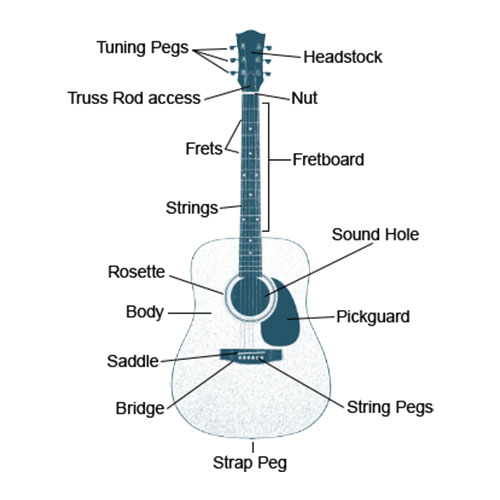
History of the Modern Acoustic Guitar
Acoustic Guitar Anatomy Reference
Body
The body of the acoustic guitar is hollow. Spruce, red cedar, rosewood and other woods are used for acoustic guitars.
Bridge
The bridge holds the strings and or saddle to the body of the guitar. Sometimes has a whammy or tremolo bar attached to it.
Fretboard
The fretboard is the top side of the guitar neck containing the fret wires and usually inlays. The scale of fretboards vary on the types of guitars and their manufacturers. Fender style guitars and Gibson style guitars vary in size and typically in number of frets. Fretboards are made from a wide variety of woods including the more common maple, rosewood, or mahogany.
Frets
Frets are the metal strips or wires spaced out across the neck. Frets allow the string to resonate a note at the point where the string is pressed down on the fret. The number of frets on a guitar depends on its make and model
Headstock
This is the head of the guitar where the tuning pegs are installed. Each guitar's headstock is differently shaped depending on its manufacturer. Some headstocks spread the tuning pegs out 3 to each side, while others have all 6 (or 7) on one side of the headstock as well as other combinations depending on manufacturer.
Nut
The nut holds the strings above the fretboard at the top of the neck. The nut is glued to the headstock and top of the fretboard. Each string is placed in a notch on the nut. Nuts are typically made from plastic, wood, bone, ivory or other material.
Pickguard
The pickguard protects the body of the guitar and its finish from scratches from picks and fingernails. Pickguards are made out of plastic, vinyl as well as other materials. On acoustic guitars, pickguards are glued to the guitar's body under the sound hole and usually around the rosette.
Truss Rod
This adjusts the bend in the neck of the guitar. The neck is usually bowed slightly to keep strings from buzzing on frets and for the overall setup of the guitar. A single rod goes through the neck of the guitar and can be loosened or tightened to achieve this. Unless you know how to adjust this properly, it's usually a good idea to leave this as a job for luthiers or guitar techs. Improperly adjusted truss rods could potentially damage the neck of the guitar or mess up the intonation.
Tuning Pegs
One tuning peg for each string. This is where the end of the string is wrapped typically 2 to 3 times. Tune the guitar with these pegs by twisting these to adjust string tension to the desired note.
Saddle
The saddle where the strings are held up above the neck from the bridge. On acoustic guitars, this is the thin strip of plastic, bone or other type of hard material in the bridge.
Strap Pegs
These hold the guitar strap to the guitar's body at the bottom of the guitar's body as well as somewhere near where the neck and body are connected depending on the model of guitar.
Strings
Guitar strings are made from steel, nylon, or other material such as copper, zinc and titanium. The lower strings are wound around another reinforcement string in the middle. Classical style guitars are usually strung with nylon strings.